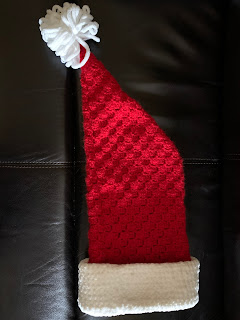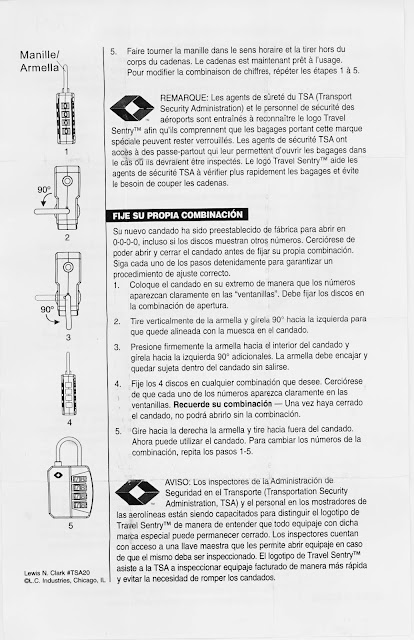After making the
Grinch scarf, I decided to make a matching Santa hat. I wanted to use the same stitch pattern, corner-to-corner.
Dimensions
Length of red part of the hat, measured to pointy tip: 21.5"
Width of red part of hat: 9"
White cuff: 4.5"; when folded over, about 3 3/4" of the cuff is visible. Since the cuff has to be wider than the hat, the cuff measured 10" wide, lying flat.
Materials
Red Heart Supersaver - Cherry Red - about 275 yds
Bernat Baby Blanket - White (for cuff and pompom) - about 45 yds. (Note about this yarn: I've read that if you use this yarn with loose stitches, either loosely made or the taller stitches in crochet, the yarn will start to "worm" as you wear it/wash it. That means you end up having floppy loops hanging about. The yarn is slippery and slides by itself easily. It was recommended to stick with tight single crochet (sc) stitches to prevent this. It is used very successfully for making amigurumi figures in this manner. So be forewarned!)
Crochet hook US H (5.0mm) and US I (5.5mm)
Gauge
13.5 x 13.5 "C2C squares' =10" x 10" using H hook.
Instructions
In order to decide how wide to make the hat, I used my scarf to measure. I wrapped the scarf around my head, covering my ears the same way I wanted the hat to do so. This turned out to be 27 squares (the c2c squares) for me. Choose an ODD number of squares, closest to your hat size. Since the brim is pretty firm without much stretch, round up, rather than round down if it's 50-50 one way or the other.
Alternatively, measure the circumference of where you want the brim to lie, subtract 2" and work c2c until the short side of your triangle measures this dimension. Choose an odd number of squares that gets you closest.
So, I proceeded to make the hat flat, 27 squares wide using the corner-to-corner technique. That meant working from one corner until I had 27 rows completed. I then had a triangle, 27 squares along each side, 27 squares along the diagonal. At this point, one of the short sides of the triangle is the size of your hat brim, the part that goes around your forehead, over your ears and to the back of your head. Now you decide how many additional rows you want to work. If you fold the triangle in half like this (Fig 1) and measure where indicated, it will tell you the measurement where the narrowing of the hat will begin. For my hat this was 10". If you measure from the top of your nose bridge even with your eyebrows over the top of your head this will tell you where the hat will begin to narrow. For me, 10" was sort of the back top of my head. I wanted it a little longer so I aimed for about 13" so I needed 4 more rows.
 |
Fig 1
|
Work 'even' (no more increases in number of squares) the length you decided. By this, it means you will no longer increase along one side, the same as you did with the scarf when making the sides straight. Each row, for me, was 27 squares. I worked 'even' for 4 more rows of 27 squares each.
Now my hat looked like the yellow portion of Fig 2.
 |
| Fig 2 |
|
|
I am now going to work with a smaller swatch for illustrating the instructions. I'll use yellow and green as in the diagram, scaled down for brevity, but it all works the same on a full size hat. You would use red for both of the sections in yellow and green. I am just showing two colors for clarity.
Here's my mini-hat, Fig 3.
 |
Fig 3
|
I am at the same place you are, just finished the length I want. Now, I will start with green. You stay with red, but follow along for the process.
If you ended at the tip of the hat, ch1, clip yarn (leave a long tail to use for sewing the long edges together) and draw through the last loop, flip over so the point is on the left top, and join the yarn at the lower right of the slanted row. If you ended already there at the lower part of the slant, then flip over and keep going.
Do the next row as you normally would, but go HALFWAY up the row. Since you have an odd number of squares, you will go ONE LESS than half-way, for my mini swatch, that's two squares. End with the sl st to the next square and stop at this row, Fig 4.
 |
| Fig 4 |
|
|
|
The next square we want to do is going to be straight above the current one. We know how to do that: turn, ch 6, in the 4th dc from the hook work 1 dc, then work 1 dc in the next ch, 1 dc in the next ch, sl st etc. Continue as usual making squares along the diagonal until you get to the last column, Fig 5.
 |
Fig 5
|
We want to keep this edge vertical. We know how to do that: ch1, turn, work 2 sl st, then, in the ch-3 loop one more sl st. Ch3, work 3 dc in the loop, sl st to the next square, as usual; keep doing the squares as usual until you arrive one column BEFORE the last square in the previous row. For my test swatch, I am already there, Fig 6. For yours you'll be working several squares before you get to this point. The idea is that this row will be ONE SQUARE SHORTER than the previous row. For my previous row I had 2 squares, so this row will have one. The arrow points to the last sl st made, thus ending this row.
 |
Fig 6
|
Now I need to go straight up from this point. We know how to do that: turn, Ch6, 1 dc in the 4th ch from hook, 1 dc in next ch, 1 dc in next ch. Sl st to the ch-3 loop of the square below and over 1. Because I've made such a small swatch, I am done because there's just one square at the point. On your hat you will have several rows, each one having one fewer squares in it, until you get to the last row where you are making just one square at the point, Fig 7.

The two sides of the hat are symmetrical and look like Fig 2. In summary, you will work the yellow rows as shown in Fig 7, then the green rows. When doing the yellow rows, you do normal c2c. When doing the green rows, you keep one edge straight and the other edge shorter, one block at a time... you move up vertically one column sooner than you would if you were doing a normal straight edge. You stop when you have made a row with just one square in it. After the final sl st: ch1, clip yarn (if you don't have a long sewing tail on the other point, make one here) and draw through the last loop.
 |
Fig 8
|
Sewing
Fold the hat in half lengthwise and using mattress stitch, stitch the two long sides together. Weave in the ends.
With the two slanted edges lined up, with the bottom of the V toward you and the points farthest away, place the edges near each other as in Fig 8.
Abbrev: dc3tog = in the same stitch: (yo, insert hook in stitch, yo and draw through stitch, yo and draw through 2 loops) 3 times, yo and draw through all loops on hook.
Attach red yarn at purple dot. Work dc3tog in purple space, sl st to green dot.
Connector: Ch3, dc3tog in yellow area, sl st to yellow dot, turn, dc3tog in orange area, sl st to orange dot, turn.
Repeat "Connector" all the way to where the points meet. At the point: ch3, dc3tog in lime green area, turn, dc3tog in blue area, ch 1, cut yarn, draw through last loop, weave in ends.
Cuff
Using H hook and white blanket yarn, work with the outside of the hat facing toward you. (This will make a finer "popcorn" look to the cuff when turned; if you like the coarse texture then you should work the cuff with the inside of the hat facing toward you.)
 |
Back of sc
|
 |
Front of sc
|
Ch 1, work sc around the edge of the hat, sl st to the starting stitch. Work tightly for two rows. On the next row, switch to the I hook for the remainder of the cuff. Work sc rounds until cuff is the depth you wish. I worked the white 4.5"; when folded over, about 3 3/4" of the cuff is visible. Be sure to try on the hat frequently as you work the white to make sure the fit is correct. Since the cuff is by necessity being done with tight sc stitches (see the note above, with the yarn specification) there won't be a lot of stretch, so fit is important.
Pompom
With blanket yarn,
wind the desired number of loops around a piece of cardboard with the
desired width. I used 2.5" and 45 loops. You will not cut the loops. Use a long
piece of cardboard for wrapping, so you can keep it to one layer of
loops. This makes sure all the loops are the same size. Use a doubled
length of yarn drawn through all the loops to tie a knot around the
loops. Remove the cardboard and shake the pompom and separate the loops
to make it a random tassel of loops. Do not attach to the hat yet if you plan to soften the hat by washing it first. Leave a long enough length of yarn on the pompom to tie it to the hat.
Finishing
For acrylic yarn, wash the hat and dry in the dryer with fabric
softener to fluff and bloom the yarn. Attach the pompom after this. Tie
the pompom to the end of the hat using a shoelace knot, with an extra overhand knot, just like you
would secure your shoelaces. Remove the pompom to wash the hat. Wash the pompom by hand when needed. Fold the cuff over, leaving two rows of white stitches on the inside.
To wear the hat
The part with the 'hump' in it is on the top of your head; the straight edge is against your back. Flop the hat to one side or the other, or squish it straight down your back.





































